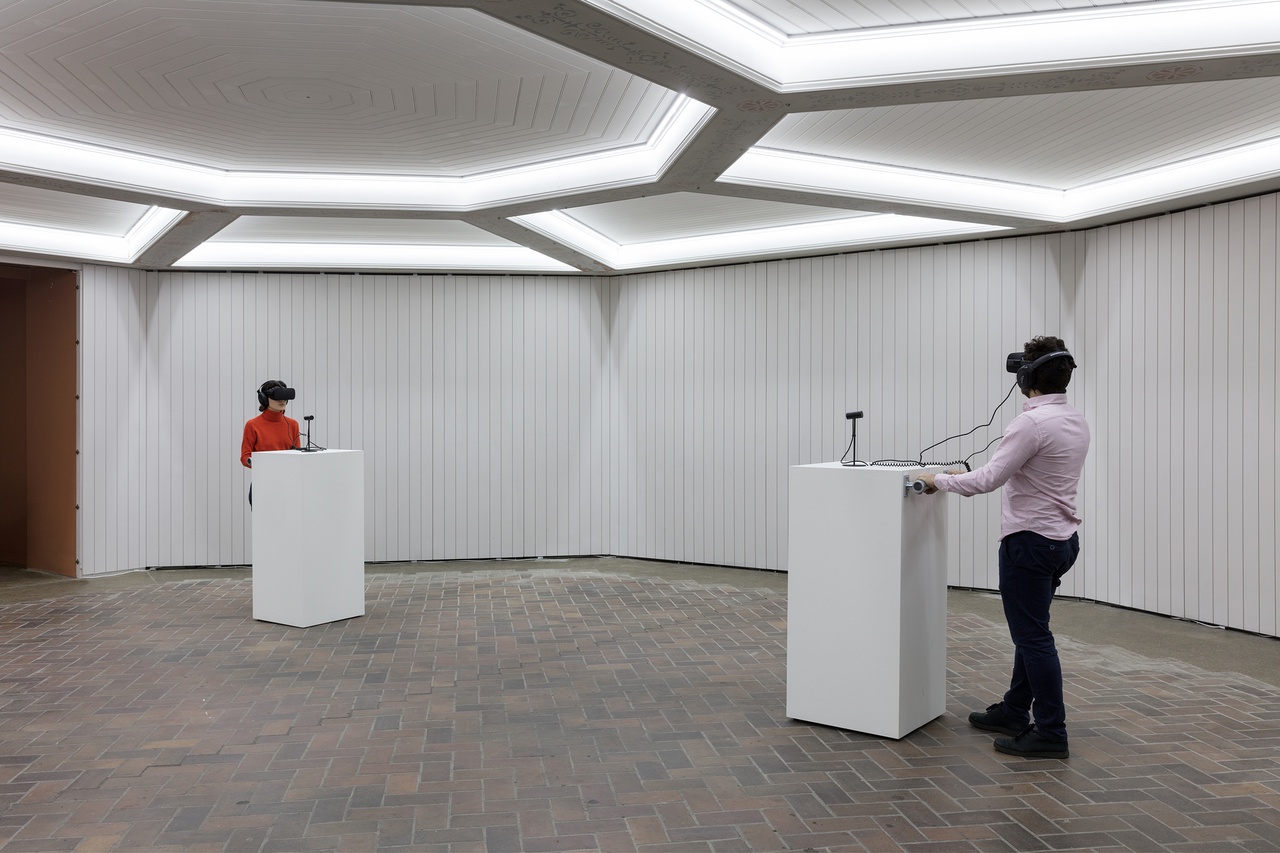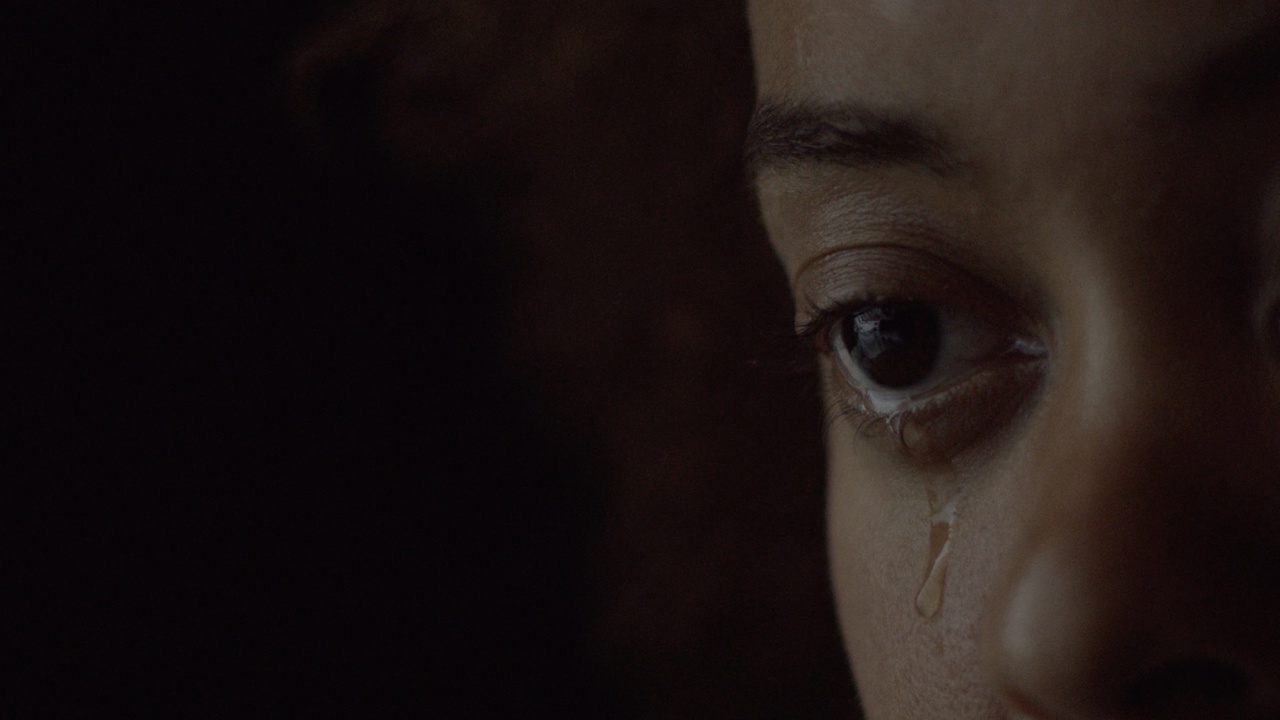TRAUMA AND VIRTUALITY

Jordan Wolfson, „Real Violence“, 2017, Installationsansicht / installation view
“The real is not a kernel, conveniently rock hard and discernible through the veil of fiction. It is instead the very structure, the warp and weft of the veil.” Susan Willis [1]
Although we – in our Western, networked societies – have made decent strides in disabusing ourselves of the perception that the “digital” and the “physical” are separate and distinct spheres, significantly less has been adequately articulated about the nature of the real within the mucky, mixed-up world we now inhabit. This is to say that, while we now know with a great deal of certainty is that the internet is real, we seem only increasingly uncertain of how that real feels and how it operates on us. Following Susan Willis’s formulation quoted above: The composition of reality/fiction’s veil seems to shift over time. What is the warp and the weft of the “veil”? What is its texture? What does reality feel like now?
When we stumble into the unfortunate business of trying to define the real or give shape to reality – especially after or with the internet – the concept of the “virtual” is often called up as its inverse. This has been the case since at least the 1990s and has largely been promulgated through the plots of science fiction books and movies – and more recently, also through contemporary art and its own struggling love affair with the virtual. Contemporary art shoots its shot with the virtual both through the direct use of virtual reality (VR) technologies and through the implementation of rhetorics of virtuality to describe work that grapples with the perceived divide between these estranged siblings – the real and the virtual.
To write a history of this infatuation would be a far greater project than I have the space or expertise to tackle here. For now, I’m interested in just two moving image artworks – Jordan Wolfson’s “Real Violence” (2017) and Arthur Jafa’s “Mechanics of Empathy” (2017) – that both draw out this question of the virtual, to potentially similar ends. On the way down, both suck into their orbit timely questions around violence, trauma, spectatorship, and the ethics of witnessing in a specifically American context.
Endeavoring to historicize and define the virtual’s presence in popular discourse, Brian Massumi writes that despite its popular use, “the virtual must […] be understood as a dimension of reality, not its illusionary opponent or artificial overcoming.” [2] Massumi’s clarification is a covertly complex one, but the gist of it is that the virtual is not oppositional to the real. Rather, if anything, it opposes “the actual.”
Massumi: “… the question of the virtual, connected in this way to the question of perception, encourages a reconsideration of the place of abstraction in our lives. It forbids placing the abstract in simple opposition to the concreteness of experience, or plotting it mechanically into an alternative between the artificial and the real – as if the artificial did not have its own mode of reality. The issue becomes, not an epochal struggle between the artificial and the real, but more positively the formative relation between the virtual and what actually appears. The issue becomes the relation of the virtual to the actual, as it pertains to perception.” [3]
Recontextualizing the “virtual” in contemporary art as Massumi’s virtuality, and not solely the pop virtuality of science fiction, allows us to consider how certain artworks take as their subject “the formative relation between the virtual and what actually appears” and, in turn, make crucial commentaries on the mouthfeel of the reality that we experience – or if we’d like to get fancy: commentaries on the phenomenology of digitally networked reality. The two works under consideration here, “Real Violence” and “Mechanics of Empathy,” I’d like to argue, do this work.
In many ways, “Real Violence” and “Mechanics of Empathy” could not be more different. For one, “Real Violence” – so far only exhibited once publicly in the US, in the 2017 Whitney Biennial – is a virtual reality experience fed to audiences through Oculus Rift headsets. Once “in” the headset, the viewer lands, after a nauseating rotation through the sky, on a New York City street. The artist Jordan Wolfson stands center screen, with a red-headed man kneeling, ISIS-style, in front of him. There are a few people milling about in the distance. A Hanukkah blessing plays in the background as Wolfson starts beating the man. The prayer stops, and we’re left with diegetic noise as the beating continues. At some point the noise stops, too, and we’re just watching the beating. At some point, the camera perspective flips and we’re watching upside down. At some point, maybe just as you’ve braced yourself for this to go on for a while, everything goes black and we return to the bright light of the gallery. “Mechanics of Empathy,” on the other hand, is a film.
At first, it seems very similar to Jafa’s well-known “Love Is the Message, the Message Is Death,” in that it also strings together found clips of black people. However, here the footage is more specific, focused on police brutality against black people and gun violence, and is taken from a more limited range of sources. Additionally, unlike “Love Is the Message,” “Mechanics of Empathy” incorporates Jafa’s own original footage as well – particularly close-ups of a young black woman’s face, with tears welling in her eyes.

Arthur Jafa, „Mechanics of Empathy“, 2016, Filmstill
Though very different kinds of subjects inhabit their works – quite simply: white men vs black people – Wolfson and Jafa share an express fixation on violence. Wolfson’s “Real Violence” is in part sheer performance of violence as he bludgeons another man (in actuality, an animatronic figure, masked by CGI) with a baseball bat. Jafa, on the other hand, does the unpleasant work of scraping the internet for documentation of anti-black violence. Both artists take the necessarily abstract concept of violence and not only make it their subject of inquiry, but their material as well – pausing its circulation and attaching it to their preferred subjects – or really, positing it as endemic to their subjects’ existence. Jafa considers violence and horror as inextricable from black life, [4] and Wolfson argues that violence is all-pervading – though it seems that in his view, it circulates rather indiscriminately, albeit while being actualized upon various bodies with varying degrees of force.
While violence is certainly central to both the concept and on-screen action in both of these works, the use of violence is of less value when making a comparison between Wolfson and Jafa. Rather, it is the use of violence to make work about the experience of witnessing violence and the tactics used therein that makes them each other’s complements and compatriots in a quest to comment on the phenomenology of a spectacular social media society and the virtuality of trauma in a networked internet age. The virtuality of trauma is thus, following Massumi again, using the term “virtual” to describe that which opposes the “actual,” or as Massumi helpfully reframes it, that which is not sensuous . If the actual defines the realm of the senses, the virtual describes the things that live in reality but which are nonsensuous . This is as good a description of the internet as any as far as I am concerned – a realm where nonsensuous interactions, conflicts, intimacies may not make observable contact with our flesh yet feel very real to us.
And in this realm, trauma is hot right now. Or rather, trauma is a primary affect that defines peoples’ engagement with the internet in contemporary culture. For one, there is a great deal of content about trauma (see the booming publishing markets for writing surrounding #MeToo, and on a longer timeline, #BlackLivesMatter). Trauma is also used as a litmus test, communities online forming around shared traumas-cum-identities. But finally, trauma is hot right now in that there is a growing amount of attention paid to the question of trauma as it relates to a phenomenology of the internet. What does it mean to be traumatized? What does it mean to experience violence? And these things, in the realm of the virtual – the nonsensuous .
For example, in the earlier 2010s, after #BlackLivesMatter became a widely known hashtag, it was deemed important to circulate videos of incidents of anti-black police violence in order to shed light on the fact that the cops were, indeed, racist. However, quite quickly, public discourse began to shift toward a suspicion of the idea that such content had any utility toward “justice.” People began to argue that such imagery did not so much furnish evidence toward justice being served as spectacularize black death in a country with an already voracious appetite for it.
This argument has given way to a slightly mutated version of itself in the time since, combining earlier suspicion of utility with “trigger warning” discourse to say that such content should not be shared – or in some cases, created – because it can traumatize or retraumatize audiences. For instance, it is this position that characterized the recent debate surrounding the music video for Childish Gambino’s “This Is America,” which showed the actor-musician massacring a black church choir with a machine gun, calling up for many the still-open wound of the massacre of nine black churchgoers in Charleston in 2015. Doreen St. Félix wrote, for the New Yorker , that the music video was quickly deemed a “powerful rally cry against gun violence, a powerful portrait of black-American existentialism, a powerful indictment of a culture that circulates videos of black children dying as easily as it does videos of black children dancing in parking lots.” However, at the same time, “a lot of black people [hated] it. Glover forces us to relive public traumas and barely gives us a second to breathe before he forces us to dance.” [5] Much of the criticism surrounding the video centered on this point, the forced reliving of trauma.
Wolfson and Jafa too present violence to viewers without much cushioning, but unlike “This Is America,” which aims for a blind provocation – the kind of thing that music videos are good at, sensationalized reworking of ideas and images lifted from more insular artistic circles – Wolfson and Jafa level attacks on the machinations of virtual trauma in order to pick apart how it actually works. Both offer a “theoretical practice” of film rather than an “ideological practice,” aiming to “break identification and thus promote a critical awareness of the spectator” rather than “promote identification.” [6] Neither “Real Violence” nor “Mechanics of Empathy” simply take an interest in representing violence and trauma (on the one hand of the blunt force variety, on the other the slow, suffocating sort that seeps from the bone-deep rot of American anti-blackness), but they make their subject the very process of bearing witness, of being a spectator, of watching.
“Real Violence,” for instance, applies pressure to the spectator position, presenting violence that appears to be actual but whose actuality is an impossibility. Titling the work “Real Violence,” while making the work a virtual reality experience, Wolfson introduces an initial paradox, one that is only further complicated by the necessary unreality of the violence depicted and the viewer’s simultaneous – probable – disgust. Basically, the only real thing is the feeling one’s left with – whatever that is. The dynamic recalls the situation described in Julian Dibbell’s 1993 article in the Village Voice, “A Rape in Cyberspace,” which chronicles a sexual assault and its aftermath in a text-based online community called LAMBDAMOO. Dibble wrote that “what happens inside a MUD-made world is neither exactly real nor exactly make-believe, but nonetheless profoundly, compellingly, and emotionally true.” [7] Perhaps we can say the same about any convincingly constructed visual environment – be it in a virtual reality headset or on a computer screen.

Arthur Jafa, „Mechanics of Empathy“, 2016, Filmstill
It might seem a stretch, on the other hand, to sweep Jafa’s “Mechanics of Empathy” into the virtual, categorically; its form appears purely cinematic. However, following Paul Virilio’s position in “The Vision Machine,” where the theorist writes that “the moment high-speed photography was invented, making cinema a concrete possibility, the problem of the paradoxically real nature of ‘virtual’ imagery was in fact posed” [8] – we can say that Jafa’s cinema, in this instance, is a virtual one. “Mechanics of Empathy” turns its gaze on the spectator’s relationship to the real imagery of anti-black violence, not simply showing the thing itself, but also showing a black woman watching it. The viewer enters the space only to find that they are not here to watch the horror of American violence, but to watch someone else watch it. What goes unsaid, however, is that the black woman’s tears on-screen are faked, and the whole relation totally constructed. Virilio also wrote that digital technologies “[fuse/confuse] the factual (or operational, if you prefer) and the virtual [and lead to] the ascendancy of the ‘reality effect’ over a reality principle already largely contested elsewhere.” [9] “Mechanics of Empathy” is a virtual first in that it privileges the “reality effect” of the woman’s tears, and second in that it centers that virtual or nonsensuous trauma of anti-black violence on the internet.
Again, by forcing a critical awareness of the spectator, these two works destabilize the viewer’s positioning such that the works might open onto this other, wilder territory where the nature of spectatorship and experience with the internet are thrown into question. In “Real Violence,” we are offered the possibility that a virtual image or experience might very well be as emotionally real as anything else. In “Mechanics of Empathy,” we seem to be offered a similar potentiality, only to be ejected from experience and thrown across the room, back into our seats. The film layers the spectator’s strangely adjacent positioning over the black woman’s – making difficult any attempt to identify into the work. Side by side, the two works don’t illuminate as much about virtuality itself as they do a looming question about its ethics.
To quote Massumi again: “At its farthest stretch, as Felix Guattari reminds us, the ultimate significance of the virtual resides in ‘universes of value’ that are ‘incorporeal’ in nature (nonsensuously real). In this axiological dimension, as relating to universes of value, the theory of the virtual is directly ethical: it immediately pertains to courses of action that make a dynamic life difference …” [10]
If the virtual’s significance lies in its ethics, then 1) this is only increasingly and more urgently the case, as the virtual (nonsensuous) colonizes more and more of our world; and 2) Wolfson and Jafa are two – of probably numerous – artists and filmmakers who engage this ethical dimension. In fact, it is likely that it is possible to revisit much of contemporary art’s engagement of virtuality and tinker with its expectations and definitions. Such a refocusing would likely crack open the potential for contemporary art and politics to more adequately and with more dexterity navigate the relationship between the internet, our bodies, our fuzzy notions of the real and the virtual, and the full-bleed between seeing, reading, and experience that seems to rule our lives, at least in America.
Image credit: Courtesy of the artist, Sadie Coles HQ, London, photo Andrea Rossetti
Notes
| [1] | Quoted by the late Mark Fisher in a 2005 post on kpunk.org, http://k-punk.org/left-hyperstition-1-the-fictions-of-capital/. |
| [2] | Brian Massumi, “Envisioning the Virtual,” in: Mark Grimshaw (ed.), The Oxford Handbook of Virtuality, Oxford 2014, p. 55. |
| [3] | Ibid., p. 56. |
| [4] | Jafa often makes note of this position. To quote a May 2017 conversation at the Museum of Contemporary Art Los Angeles with Saidiya Hartman: “I think that black being is inextricably bound up with horror.” See https://www.youtube.com/watch?v=YhX6Cb2MsDQ. |
| [5] | Doreen St. Félix, “The Carnage and Chaos of Childish Gambino’s ‘This Is America,’” https://www.newyorker.com/culture/culture-desk/the-carnage-and-chaos-of-childish-gambinos-this-is-america. |
| [6] | Luciana Parisi/Tiziana Terranova, “A Matter of Affect: Digital Images and the Cybernetic Re-Wiring of Vision,” in: Parallax , vol. 7, 4, 2001, p. 123. |
| [7] | Julian Dibbell, “A Rape in Cyberspace,” in: The Village Voice , December 1993, amended version later published online at http://www.juliandibbell.com/articles/a-rape-in-cyberspace/. |
| [8] | Paul Virilio, “The Vision Machine,” in: The Vision Machine, London: British Film Institute, 1994, p. 61. |
| [9] | Ibid., p. 63. |
| [10] | Massumi, “Envisioning the Virtual,” p. 67. |
